Holbein Gardens: Delivering a Low-carbon Structure with Reclaimed Steel
Written in The Structural Engineer, March 2023.
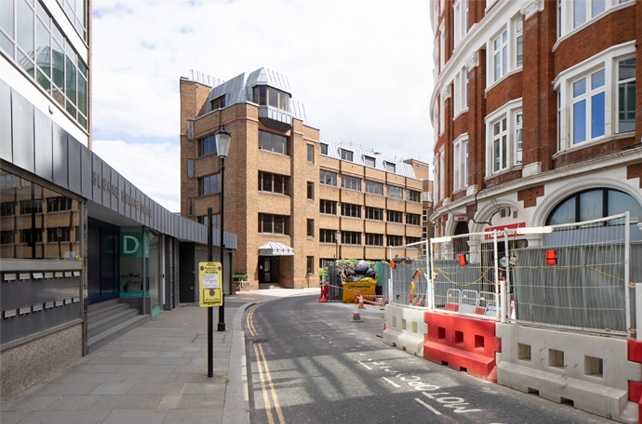
Existing photo of Holbein Gardens, © Barr Gazetas
The original building at 7 Holbein Place, London could not be called special. It was a 1980s concrete-framed building, two bays wide, with one-way spanning slabs going front to back onto downstand beams and a central band beam. It was not of unique architectural merit and, at 5m × 6.5m, the grid was tight compared with most modern office buildings.So, what makes this building unusual and why does its redevelopment warrant an article? The answer is that the development is Grosvenor UK’s flagship sustainability and first net-zero carbon project. And it is one of the first UK developments to incorporate reclaimed steel.
From the outset, the project team’s desire was to find ways to make the construction as low-carbon as possible, while still creating a premium office space. Working with Barr Gazetas architects, the team identified five key strategies to achieve this aim:
- Retaining as much of the existing building as possible, including the facade and structure
- Reusing materials from the building or sourcing these from other buildings locally, including steelwork and bricks
- Using low-carbon materials for the new structure, such as cross-laminated timber (CLT) for the floors and walls and Cemfree™ concrete
- Using sustainable technology and biodiverse interventions, including landscaping and a green wall (Figure 1)
- Using efficient servicing and targeting sustainability accreditations including BREEAM Outstanding, WELL Gold and NABERS 5 Star.

Fig 1. Proposed transformation of Holbein Gardens, © Barr Gazetas
Refurbishment of the existing building
Located next to Sloane Square station, over a Thames Water sewer and close to several sensitive residential properties, the building has its constraints. The process of overcoming these was greatly simplified by retaining a significant proportion of the original fabric. The original load paths were retained, along with much of the existing concrete frame and brick facade, with load increases of less than 10% from a lightweight extension (Figure 2). This minimised the impact on the surrounding infrastructure, simplifying approvals.
Limited archive information on the existing building was found following an extensive search of building control records, client archives and documents stored in the building. Intrusive investigations therefore had to be undertaken to confirm the condition of the existing building. These included:
- Concrete scanning using ground-penetrating radar
- Localised breaking out of concrete to confirm reinforcement
- Testing of concrete using drilling dust and core samples, to confirm strength and check for carbonation and chlorides
- Geotechnical boreholes and trial pits.

Fig 2. Isometric of proposed works at Holbein Gardens
A lightweight one-storey vertical extension was proposed, with much of the additional load offset by the removal of a non-structural screed to each floor. The increases in loading, of up to 10%, were calculated and the existing concrete elements justified by back-analysing the structure and inputting the material properties and reinforcement confirmed by the intrusive investigations. The existing columns and foundations were found to have sufficient capacity to carry the additional load without strengthening. The existing reinforced concrete shear stability walls were found to be adequate and did not require additional stability elements.
The existing facade (Figure 3) comprised brickwork supported on stainless steel angles, fixed back to concrete toes projecting from the downstands. The condition of the supports and masonry was found to be good, allowing much of the existing facade to be retained, which reduced embodied carbon. Thermal performance was improved by upgrading the insulation in cavities, requiring the sequential removal of the blockwork inner skin. Elsewhere, the desired U-values for the existing external walls of 0.22W/m2.K were achieved by insulating internally.
The fire resistance period of the existing concrete structure did not change from 60 minutes, with checks on the reinforcement confirming there was sufficient cover to meet this. Retaining most of the concrete and facade meant that the embodied carbon of the redevelopment was low, but the challenge was to also reduce the embodied carbon of the new structural elements.
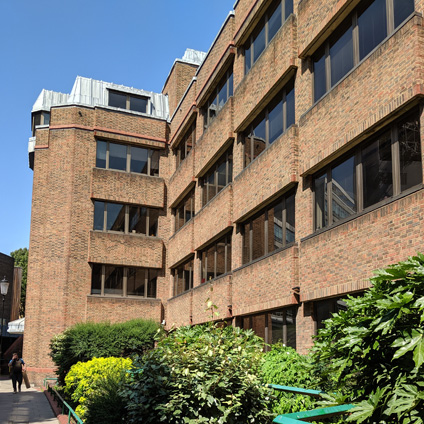
Fig 3. Brickwork façade of existing building, © Barr Gazetas
CLT floors and roofs
The new structure includes one additional office floor and a roof terrace structure. Timber was chosen for the new floor and roof structure, both for its low embodied carbon and ability to store carbon, and because it is lightweight compared with other structural materials such as concrete. The dry construction avoided the need for wet trades on site, and Eurban’s role as both CLT and steel subcontractor ensured the efficient integration and erection of the steel and CLT frame.
Due to the tight planning height requirements, steel beams and columns were chosen to maximise floor-to-ceiling heights and allow for service integration. The CLT floors (Figure 4) typically span 5m at 200–220mm thickness and most of the extended shear walls were also in CLT. The underside of the CLT floors was exposed with an industrial grade finish, which was chosen because the soffit would be partially hidden with services. The new CLT walls were boarded out to meet fire resistance requirements. Shallow Slimflor® beams form the roof, with dynamics being the critical design criterion for much of the CLT/steel system. Acoustic considerations required the introduction of cement board over the office floor to add mass and reduce noise transfer.
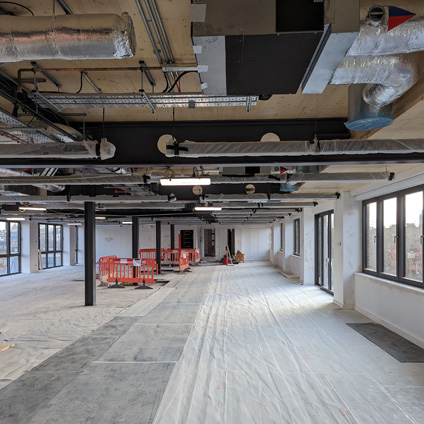
Fig 4. Installation of CLT floors
The fire engineering strategy was a risk-based approach to justify the use of mass timber in the building, as only the upper floors were to incorporate CLT. The structural fire performance of the CLT was established through char rate calculations; determining the required thickness of the CLT to leave a sufficient layer of uncharred timber during the fire resistance period, to maintain structural integrity in the accidental load case. Calculations accounted for delamination of the CLT, and a surface spread of flame treatment was applied to the underside of the timber.
The fire implications were scrutinised and an approach was agreed with fire consultant, The Fire Surgery, which satisfied all parties. The lower floors and core walls were constructed in non-combustible reinforced concrete and provided a fire-designed approach to the cores and means of escape. Any CLT in the escape stairs was encapsulated with additional proprietary fire-resisting materials, as was the first 2m of any steel that penetrated the CLT walls. Steelwork was otherwise protected with intumescent paint.
Fire safety guidance1 from the Structural Timber Association (STA) was followed, with the building classified as medium-rise due to the limited use of CLT on the upper floors, the fast evacuation time, and the fact that fire brigade intervention would be predominantly from the outside of the building. Classification as a medium-rise building avoided the requirement for an auto-extinction (burnout) analysis and project-specific fire tests, which would have been considered had the building been in the high-rise category and consequence class 2B for exposed CLT.
The use of CLT for the roof structures needed careful consideration given the risk of water ingress, with water on the surface of the CLT often not visible on the underside, until long-term degradation of the timber has occurred. At Holbein Gardens, a blue roof (an attenuation measure to temporarily store water on the roof) was also required on the building and planning heights restricted the roof zone, so the CLT could not be laid to falls. However, working with roofing specialist, Bauder, to develop the details, the roof was designed with three different waterproof layers, including a temporary waterproofing layer that was installed to all CLT surfaces as part of the moisture content control plan, to limit water damage during construction. The risk of water ingress was therefore greatly reduced and considered low.
Reusing steelwork
Planning restrictions limited the height of the new building, with insufficient floor zones for deep timber beams and Grosvenor’s Fire Policy precluded timbers being used in and around the external walls, so a steel frame was proposed for the new extensions.
The steelwork forming the new frame was identified as one of the big contributors to embodied carbon and was an area that was targeted for reduction from the outset of the project. At the concept stage in 2019, reusing steel sections directly was not being widely discussed. This approach presented several challenges in relation to sourcing reclaimed steel, design considerations, and insurance questions. Several options were considered for sourcing the steelwork (Figure 5).
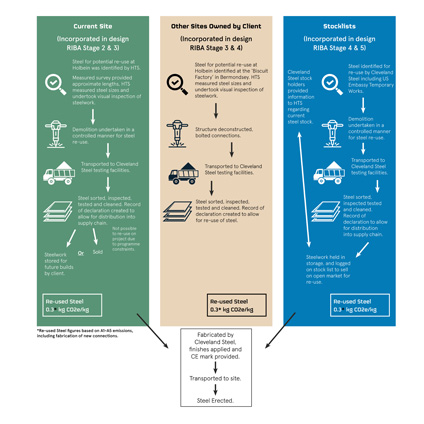
Fig 5. Steelwork sources
Sourcing reclaimed steel - existing building
The ideal source of steelwork would have been from the existing building, where a single-storey mansard made of lightweight steel sections was to be demolished (Figure 6). However, this was not suitable to support office loading. Options were considered for how the steel could be reused in the new building.
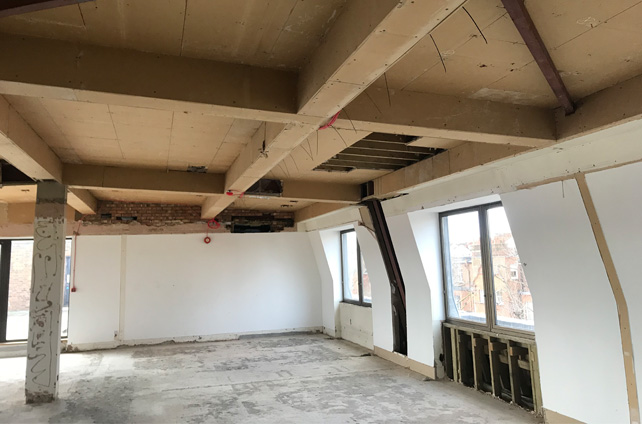
Fig 6. Steels from existing building, boarded or encased in concrete
Many of the steels were ties, typically 254mm UB sections, and simplistically it was thought that these could be unbolted and reused on the new frame, while retaining end plates, as the grid was remaining the same. However, some fabrication would still have been required and as the extent of demolition was so small, there would not have been sufficient time to dismantle the steels, remove from site, test, clean, fabricate and bring back to site without impacting the construction programme. The steels were still dismantled but reserved for use on another site.
The quick programme between demolition and erection of the new steel frame was a unique issue to the Holbein Gardens project and could be overcome on other projects, where activities such as groundworks could lengthen the programme before new steels are required.
Sourcing reclaimed steel – other sites
Steel was also identified from other Grosvenor projects that were due to be demolished. This included several warehouses in Bermondsey, London. Despite the scale of the site, the number of steels that could be reused was limited because:
- Much of the steelwork predated 1970 (when steel production became more regulated) and reuse of this steel is not covered by current guidance. More testing and justification would have been required to reuse
- Steels forming the roofs were long, deep (>1m) beams or trusses made from small angle sections, not suitable for use at Holbein Gardens
- Several buildings had concrete-encased steelwork, which would have required significant breaking-out work, risking damage to the steelwork prior to reuse.
However, a simple steel frame forming a mezzanine was identified (Figure 7). This contained 254mm UB sections and small RHS posts which were similar to sections already specified and worked well with the design. The steelwork, totalling 9t, was dismantled from this frame and sent to storage to await reuse.
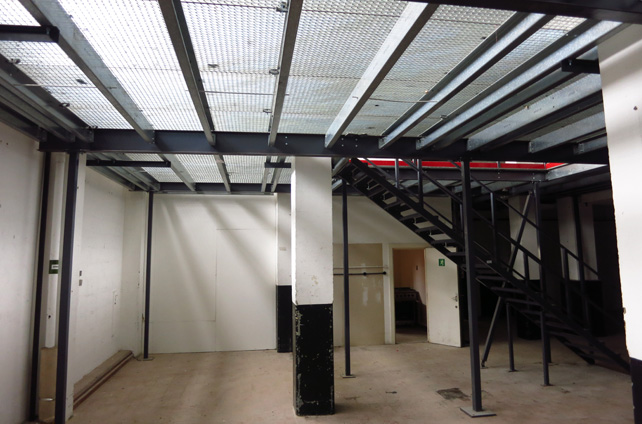
Fig 7. Mezzanine steels from Bermondsey site
Sourcing reclaimed steel – stock reclaimed steels
In addition to the mezzanine steels from the Bermondsey site, the team worked with Cleveland Steel and Tubes (CST), a reclaimed steel specialist, to source stock reclaimed steel from other sites that matched the required sizes for the new frame.
However, the quantity of available steels was limited and the larger, heavier sections, which made up the majority of the steel tonnage, could not be found or were found too late. Stock reclaimed steel was not secured early in the design programme and the design therefore had to be adaptive to suit the steel that was available at different stages, resulting in some redesign late on to suit available sections. Thanks to the partnership with CST, 16t of reclaimed stock steel was secured, around two-thirds of the total reclaimed steel on the project (Figure 8).

Fig 8. Use of reclaimed steel on project (brown = steel from Bermondsey site; blue = CST stock reclaimed steel)
Incorporating reclaimed steel into design
Designing using reclaimed steel is similar to designing with new steel. Design was completed in accordance with SCI guide P427 on structural steel reuse2, and most reused sections could be designed to the same codes and safety factors as equivalent new steelwork. The exception was buckling checks of the steels, where a modified value of γM1,mod = 1.15γM1 is recommended to be applied to reclaimed sections.
Sections were designed to a high utilisation, typically 80% or above, to minimise waste and ensure that the maximum carbon benefits of using the reclaimed steelwork were achieved. Several steels were of S275 grade, which was factored into the design at early stages, with other sections, such as European HE sections, also substituted for the new steelwork.
The history of the reclaimed sections had been investigated by CST, with much of the stock reclaimed steel coming from temporary works applications, certified from use on a film set, or unused excess material from other sites. The steels extracted from the Bermondsey site had been constructed in the last 30 years and used in a low-load application. It was therefore established that the steels had not undergone extreme design cases such as fire, impact, fatigue or plastic deformation.
The quality of the steel was good, with no noted damage. Holes or openings on the steel were small and much less than 15% of the net cross-sectional area, which is a suggested limit given in SCI P427 above which further checks might be needed.
Procurement route
The procurement route with the main contractor, Blenheim House Construction, was a single-stage, design-and-build contract (Figure 9). This posed some challenges with cost certainty, as there was no experience of reclaimed steel being delivered commercially using this procurement route before.
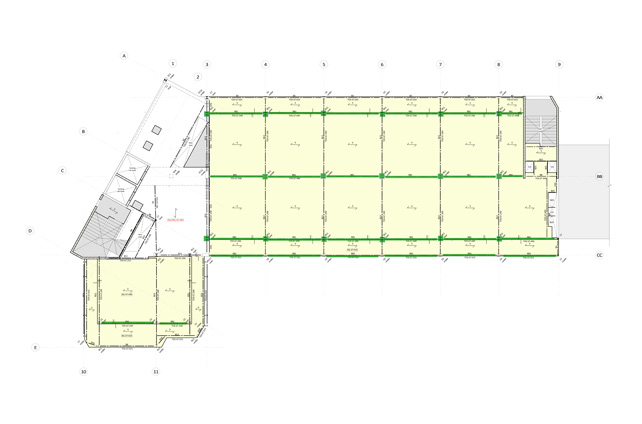
Fig 9. Tender drawing showing reused steel sections
Having CST engaged in the project from an early stage, employed as both the stockist for the main steel frame and the fabricator, was beneficial. The process was simpler than having a separate stockist and fabricator, and like-for-like steels could be swapped in at a late stage just before fabrication. It also helped to minimise any cost premiums associated with reusing the steel.
A shift in thinking and in the practice of procuring reclaimed materials, to ensure they are procured at an earlier stage of the project, will be required to reduce the need for redesigning late on to suit availability. If the client is willing to reserve steel sections earlier in the design period, this can help guarantee availability for a particular project, but can lead to less flexibility for late design changes and limit the amount of stock reclaimed steel available for other projects that might go to site sooner. With the reuse market expanding over time, it is expected that more stock steel will continue to be made available, improving the chance of obtaining specific sizes. However, Holbein Gardens had to rely on the limited stock held by CST.
Getting demolition contractors to programme in the extraction of steels, clients to understand potential additional deconstruction costs, and main contractors to understand the procurement challenges will also be essential if the market in reclaimed steel is to expand.
Testing and insurance
Sampling, testing and confirming steel members are suitable is an important step in justifying steel for reuse. This was completed by CST (Figure 10) on Holbein Gardens and followed the guidance set out in SCI P427. Steels were grouped into categories depending on function, serial size and length, and a representative sample tested to inform the design, including destructive tests to check yield strength, ultimate strength, elongation and assess chemical composition. As the steels were from several different sources and different serial sizes, this increased the number of required tests, with 12 samples tested in total in accordance with recommendations from SCI P427. Steels also underwent a dimensional assessment checking for straightness, loss of section and damage.
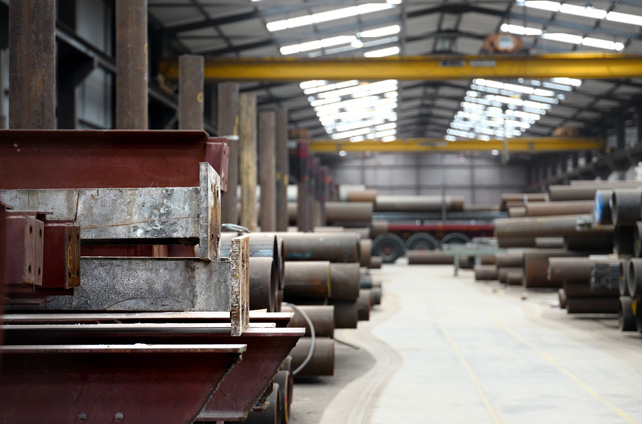
Fig 10. Steels at Cleveland Steel Yard © Philip Vile
To treat the reclaimed steelwork as a new piece of steel from a quality control perspective, it needed to be CE or UKCA marked. Once the steel has been fabricated, the steelwork contractor can CE/UKCA mark it to the execution standard EN 1090, in just the same way as for new steel. However, a steel stockist cannot CE/UKCA mark reclaimed steel to a product standard unless it has been machined, cut or welded in some way to form a fabricated piece. Having CST as steel stockist and fabricator helped streamline this on Holbein Gardens, but could be an additional consideration on other projects.
Discussions took place at an early stage with the future insurers of Holbein Gardens, to make sure they accepted the incorporation of reused steel. Once the process was mapped out and it was clear that the right testing and warranties could still be provided with the reused steel, the insurers were comfortable with the proposals.
Aesthetic considerations
Reclaimed steels will retain some imperfections and will not look like new steel. Steel plates, holes and other features from previous uses often don’t impact on their performance and, subject to assessment, can remain on the steel. However, they may need to be considered where the steel might be exposed.
On Holbein Gardens, much of the steel is hidden, but Grosvenor was keen to show these features where possible to tell the reuse story (Figure 11). The holes in the beams were generally through the webs, where previous joists had connected, or local small openings through the flanges from previous connections, and did not impact the performance of the beams. Where old web stiffeners and plates on the steel beams clashed with the CLT, they had to be removed by plasma-cutting and the steel ground down, which involved extra manufacturing; however, wherever possible these were retained.
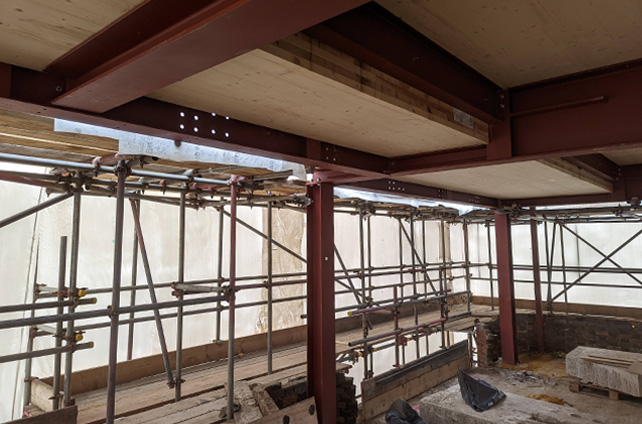
Fig 11. Installed steels showing holes from previous uses
The steels being reused from Bermondsey had been in a pinned frame, with steel beams supported on the top of columns without end plates and restrained by joists, so beam ends did not need to be cut back. However, on other projects, where steel is sourced from composite frames or larger structures, up to 500mm may need to be cut off the ends to aid with demolition and to remove end plates, which would need to be factored into the final beam lengths available.
Most of the steels at Holbein Gardens were to be exposed and existing finishes couldn’t be retained, so they were grit-blasted back to the raw steel to allow a primer to be reinstated and intumescent paint protection to be applied. If steelwork is not being exposed, it may be possible to keep the existing primer in place or shot-blast it locally to facilitate new connections. However, this wasn’t possible at Holbein Gardens.
As the reclaimed steels were taken from a small mezzanine, roofs, temporary works or were excess material, they did not have extensive finishes to protect them from fire or corrosion, so only the steel primer needed to be removed, which simplified the process. Concrete encasement, intumescent/vermiculite fire protection, and shear studs all need to be considered where these occur on existing steelwork and would have added another removal process during demolition or for the steel stockist.

Fig 12. Embodied carbon figures for new steel, supplied steel and reused steel at Holbein Gardens
